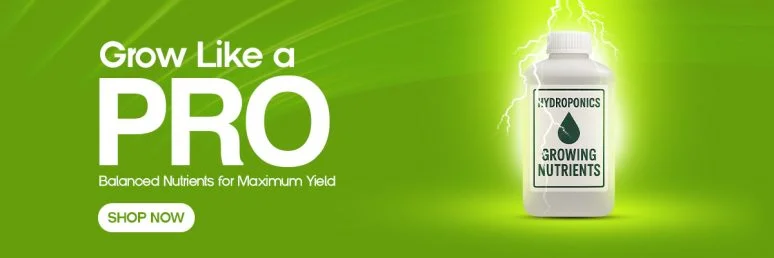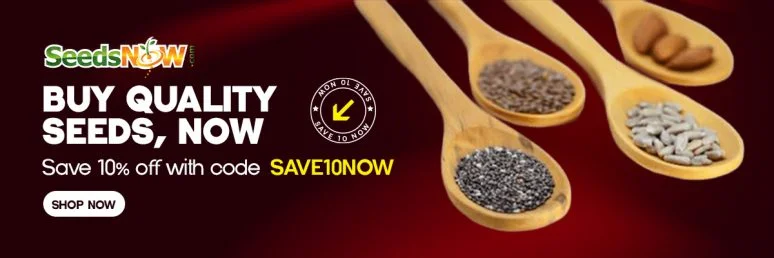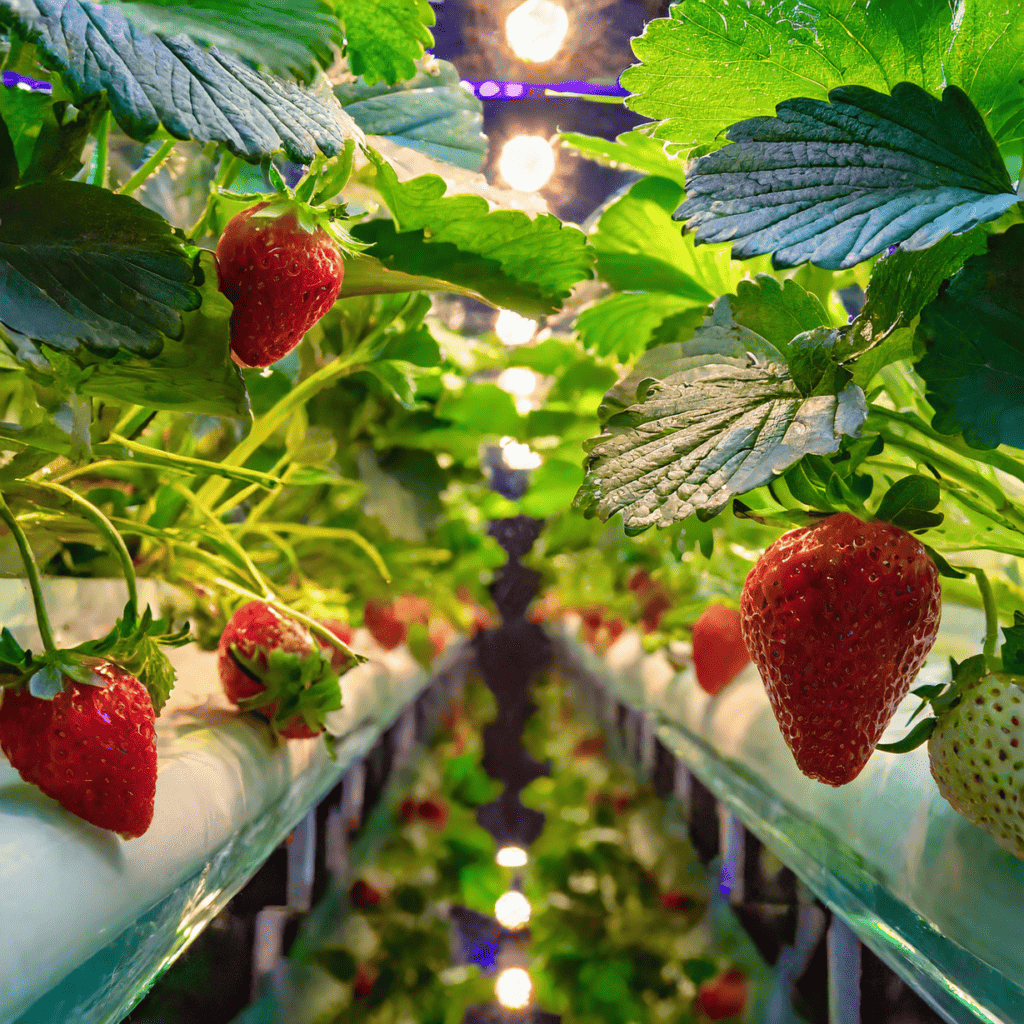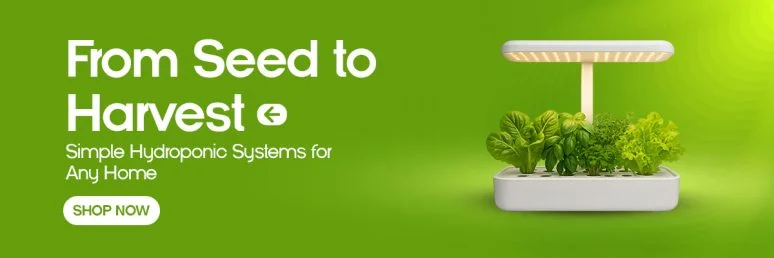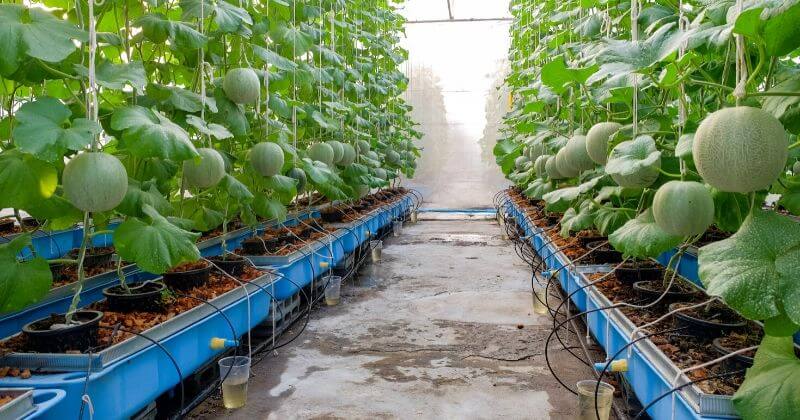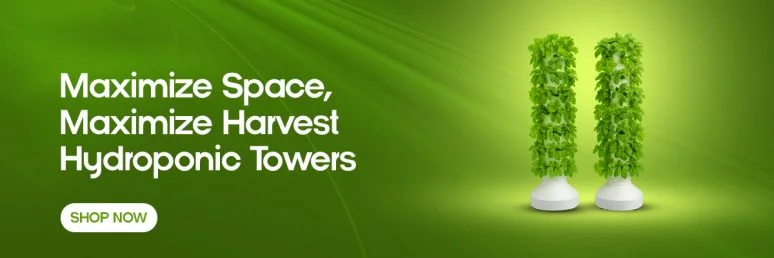Hydroponic Fruits: Your Guide To Modern Soilless Agriculture
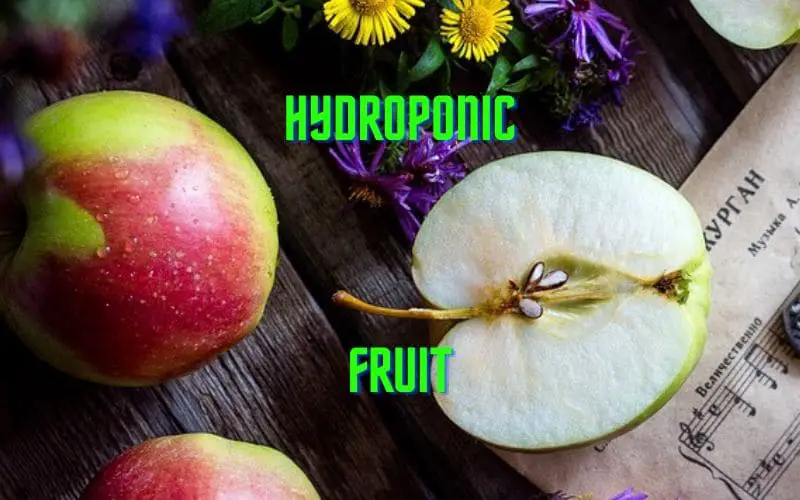
Key Takeaways
- Hydroponic fruit cultivation offers up to 30% faster growth rates and 3x higher yields than traditional soil-based methods while using 90% less water.
- The most successful hydroponic fruits include strawberries, tomatoes, cucumbers, and peppers, with specialized systems like NFT and DWC providing optimal growing conditions.
- Proper nutrient solution management is crucial for fruit development, with different formulations needed for vegetative growth versus flowering and fruiting stages.
- Farmonaut’s monitoring technology can help optimize your hydroponic setup by tracking essential parameters like pH, nutrient levels, and temperature for maximum yields.
- Even beginners can achieve success with hydroponics by starting with simple systems like Deep Water Culture before progressing to more advanced techniques.
Growing fruits without soil might sound like science fiction, but hydroponic cultivation is revolutionizing how we produce fresh, nutritious fruits year-round. By delivering nutrients directly to plant roots through water, hydroponic systems eliminate the limitations of traditional agriculture while maximizing efficiency. Whether you’re a curious hobbyist or aspiring commercial grower, this guide will walk you through everything you need to know about growing delicious fruits hydroponically. Farmonaut’s precision agriculture solutions can help you monitor and optimize your hydroponic setup for maximum yields and efficiency.
The beauty of hydroponic fruit production lies in its versatility and control. You can grow strawberries in winter, harvest tomatoes in your apartment, or cultivate exotic fruits in regions where they wouldn’t normally thrive. With the right system and knowledge, you’ll be amazed at what you can accomplish without a single grain of soil.
Why Hydroponic Fruit Growing Beats Traditional Farming
“Growing Hydroponic Strawberries – GROZINE” from www.grozine.com and used with no modifications.
Traditional soil-based fruit cultivation comes with inherent limitations that hydroponics elegantly solves. In soil, roots must search for nutrients, competing with weeds while battling soil-borne diseases and pests. Hydroponics delivers nutrients directly to the roots in perfect proportions, eliminating these inefficiencies. This direct access to nutrition is why hydroponic fruits typically grow 20-30% faster than their soil-grown counterparts.
Water efficiency is perhaps the most striking advantage of hydroponic fruit cultivation. While traditional farming often wastes up to 90% of irrigation water through evaporation and runoff, hydroponic systems recirculate water, using up to 90% less than conventional methods. This makes hydroponics particularly valuable in drought-prone regions or urban environments where water conservation is crucial.
Space utilization represents another significant benefit. With vertical systems, you can grow strawberries, tomatoes, and other fruits in stacked arrangements that multiply your growing area. A 10-square-foot hydroponic setup can produce the equivalent yield of a 30-square-foot soil garden. Add year-round growing capabilities (regardless of outdoor weather conditions), and the productivity advantages become even more pronounced.
Essential Equipment for Your Hydroponic Fruit Garden
“Hydroponic Water Additives That Enhance …” from strawberryplants.org and used with no modifications.
Creating a successful hydroponic fruit garden requires specific equipment that works together to provide the perfect growing environment. While the initial investment might exceed that of traditional gardening, the increased yields and efficiency quickly offset these costs. Let’s break down the essential components you’ll need to get started.
Nutrient Solution Components for Optimal Fruit Development
The heart of any hydroponic system is its nutrient solution—essentially the “soil” that feeds your plants. For fruit-bearing plants, you’ll need macro and micronutrients in precise ratios that change throughout the growing cycle. Pre-formulated nutrients specifically designed for fruiting plants provide the essential elements: nitrogen, phosphorus, potassium, calcium, and magnesium, plus trace elements like iron and zinc. Quality digital pH and EC (Electrical Conductivity) meters are non-negotiable tools, as fruit plants thrive in specific pH ranges (usually 5.5-6.5) and nutrient concentrations that must be monitored regularly.
Lighting Systems That Maximize Yield
Fruit development requires significant energy from light, making your lighting system perhaps the most critical investment for indoor setups. Full-spectrum LED grow lights have become the gold standard for hydroponic fruit production, offering the perfect light spectrum while minimizing energy consumption. For fruiting plants, look for lights with enhanced red spectrum output (630-660nm wavelength) to encourage flowering and fruit development. Position lights properly—typically 12-36 inches above plants, depending on light intensity—and provide 12-16 hours of light daily during fruiting stages.
Space-Saving Growing Containers
Selecting the right containers for your hydroponic fruits depends largely on the system you choose and the fruits you’re growing. For strawberries and smaller fruits, stacked PVC pipes with holes or specialized vertical towers maximize space efficiency. Larger fruits like tomatoes and peppers thrive in individual 3-5 gallon net pots or dedicated hydroponic buckets that provide ample room for root development. Whatever containers you choose, ensure they’re made from food-grade materials that won’t leach chemicals into your nutrient solution.
Water Pumps and Air Stones for Proper Oxygenation
Fruit-bearing plants have high oxygen requirements, particularly during flowering and fruiting stages. Submersible water pumps circulate nutrient solution, preventing stagnation while creating water movement that incorporates oxygen. Air pumps connected to air stones create thousands of microbubbles in your reservoir, dramatically increasing dissolved oxygen levels. For fruiting plants, aim for dissolved oxygen levels of 7-10 ppm (parts per million), which often requires more powerful air pumps than those used for leafy greens. Remember that warmer water holds less oxygen, so maintaining proper temperature (65-75°F) is essential for oxygen availability.
6 Best Hydroponic Systems for Growing Fruits
“Best Fruits for Hydroponics – Healthier …” from healthiersteps.com and used with no modifications.
Choosing the right hydroponic system dramatically impacts your success with fruit cultivation. Each system offers distinct advantages depending on the fruits you’re growing, your space constraints, and your experience level. Let’s explore the six most effective systems for producing bountiful fruit harvests.
Deep Water Culture (DWC): Simple and Effective
The Deep Water Culture system suspends plant roots directly in nutrient-rich, highly oxygenated water, making it perfect for beginners due to its simplicity. Plants sit in net pots filled with growing media, while their roots extend into a reservoir below. Powerful air stones keep the solution oxygenated, preventing root rot while promoting vigorous growth. DWC works exceptionally well for fruit plants with substantial nutrient needs like tomatoes and strawberries. The generous water volume creates a buffer against rapid pH or temperature changes, forgives occasional monitoring lapses, and requires minimal maintenance beyond regular nutrient solution changes.
Nutrient Film Technique (NFT): Great for Smaller Fruits
Nutrient Film Technique creates a continuous flow of shallow nutrient solution along channels where plant roots grow. This system excels with strawberries and smaller bush-type tomatoes that don’t require extensive root support. NFT’s primary advantage comes from its exceptional oxygen exposure, as roots receive perfect amounts of nutrients and air simultaneously. The constant flow prevents salt buildup while using minimal water compared to other systems.
For successful NFT fruit production, maintain a flow rate of 1-2 liters per minute and ensure channels slope at 1-3 degrees for proper drainage. One caution with NFT: power outages or pump failures can quickly damage plants since there’s minimal water reservoir to sustain roots. Installing backup power or alert systems can mitigate this risk for serious growers.
Drip Systems: Precise Nutrient Delivery
Drip systems deliver nutrient solution directly to each plant’s base through individual tubes and emitters. This precision makes them ideal for fruits with varying nutrient requirements or for mixed fruit gardens. The system can be recovery (recirculating) or non-recovery (drain to waste), with the former being more economical for home growers. Drip systems work exceptionally well for larger fruiting plants like full-sized tomatoes, peppers, and dwarf watermelons that require consistent but controlled moisture.
Ebb and Flow: Versatile for Various Fruits
Ebb and Flow (also called Flood and Drain) systems temporarily flood growing beds with nutrient solution before draining it back to the reservoir. This flooding cycle, typically occurring 3-6 times daily, works well for a wide variety of fruits. The periodic flooding provides excellent nutrient delivery while the draining phase pulls oxygen to the roots, creating ideal growing conditions. For more insights into hydroponic plants for food, you can explore additional resources.
The system’s versatility allows you to grow different fruits with varying root depths in the same bed. It’s particularly suitable for mixed fruit gardens or for growing companion plants alongside your primary fruits. Consider programmable timers for precise flood cycles—fruiting plants generally benefit from more frequent but shorter flooding periods than vegetative plants.
Aeroponics: Advanced Option for Experienced Growers
In aeroponic systems, plant roots hang suspended in air while being misted with nutrient solution at regular intervals. This advanced technique maximizes oxygen exposure and nutrient absorption, potentially increasing yields by 30% over other hydroponic methods. High-pressure aeroponics systems use specialized nozzles to create microdroplets (5-50 microns) that efficiently deliver nutrients while promoting explosive root growth.
While technically challenging, aeroponics rewards skilled growers with faster growth cycles and higher fruit production. Strawberries and bush tomato varieties particularly thrive in these systems. However, the reliance on consistent misting means pump failures can damage plants within hours, making backup systems essential.
Wick Systems: Budget-Friendly for Beginners
The humble wick system uses capillary action to draw nutrient solution up to plant roots through absorbent wicks. While the simplest hydroponic method (requiring no electricity or moving parts), wick systems have limitations for fruit production. They work adequately for smaller fruits with modest water needs like strawberries or dwarf peppers, but struggle with larger, thirstier fruits like full-sized tomatoes or melons.
For beginners looking to experiment with minimal investment, a wick system offers an accessible entry point. Use highly absorbent materials like cotton rope, felt, or specialized hydroponic wicks to maximize water delivery. Multiple wicks per plant will improve performance for fruiting varieties with higher water demands.
Top 8 Fruits That Thrive in Hydroponic Systems
“Plants You Can Grow in a Hydroponic Garden” from www.epicgardening.com and used with no modifications.
Not all fruits are created equal when it comes to hydroponic cultivation. Some varieties naturally excel in soilless environments, rewarding growers with abundant harvests and exceptional flavor. The following eight fruits have consistently proven their worth in hydroponic systems, offering the best combination of ease, productivity, and space efficiency.
Strawberries: The Perfect Hydroponic Starter Fruit
Strawberries reign supreme in the hydroponic fruit world, producing up to four times the yield of soil-grown plants in the same space. These compact plants thrive in virtually any hydroponic system, though NFT and vertical towers maximize space efficiency. The day-neutral varieties like ‘Seascape’ and ‘Albion’ produce continuously rather than in single seasonal flushes, making them ideal for year-round harvesting.
For optimal strawberry production, maintain EC levels between 1.2-1.5 mS/cm and pH around 5.8-6.2. Provide at least 8-10 hours of direct light daily, with temperatures between 65-75°F for day and 50-60°F at night to encourage flowering and fruiting. Expect your first harvest within 60-70 days of transplanting, with proper conditions yielding approximately 1-1.5 pounds of berries per plant annually.
Tomatoes: High-Yielding and Space-Efficient
Hydroponic tomatoes epitomize the system’s advantages, growing faster and producing higher yields than their soil counterparts. Indeterminate varieties like ‘Beefsteak’ and cherry types like ‘Sweet 100′ perform exceptionally well, producing continuously for 8-10 months with proper care. For space efficiency, choose Dutch bucket or vertical growing systems that support the plants’ substantial weight while accommodating their extensive root systems.
Success with hydroponic tomatoes requires higher nutrient concentrations (EC 2.0-3.5 mS/cm) than most fruits, along with meticulous pruning to a single or double stem. Maintain consistent temperature (70-75°F day, 60-65°F night) and provide significant light (minimum 14-16 hours daily or supplemental lighting in winter). With proper trellising and pollination assistance, expect yields of 20-30 pounds per plant—about 30% more than soil-grown equivalents.
Cucumbers: Fast Growth and Continuous Harvests
Hydroponic cucumbers grow at remarkable speeds, often ready for first harvest just 45-55 days after transplanting. The European seedless varieties (also called “burpless”) like ‘Tyria’ and ‘Socrates’ excel in hydroponic systems, producing sleek, bitter-free fruits that don’t require pollination. These gynoecious varieties (producing primarily female flowers) focus energy on fruit rather than male flowers, resulting in higher yields.
For successful cucumber production, use strong trellising that accommodates their vigorous vertical growth, often reaching 6-8 feet tall. Maintain EC levels between 1.8-2.2 mS/cm and pH around 5.8-6.0 for optimal nutrient uptake. With proper management, each plant can produce 20-30 cucumbers over a 3-4 month period, making them one of the most productive hydroponic fruits by weight.
Peppers: From Sweet to Spicy Varieties
Both sweet and hot peppers thrive hydroponically, with compact varieties like ‘Redskin’, ‘Cubico’, and ‘Hamik’ particularly well-suited to indoor systems. These plants appreciate the precise nutrient control that hydroponics offers, producing thicker-walled fruits with enhanced flavor profiles compared to soil-grown alternatives. Dutch bucket or drip systems provide ideal growing conditions for pepper plants’ moderate root systems and substantial fruiting weight. For more information on hydroponic farming models, check out this urban hydroponics guide.
Peppers require higher potassium levels during fruiting, with an ideal EC range of 1.8-2.2 mS/cm and pH of 5.8-6.3. These heat-loving plants perform best at temperatures between 70-80°F during the day and no lower than 65°F at night. While they grow more slowly than tomatoes or cucumbers (taking 60-90 days to first harvest), each plant can produce 20-30 fruits over a 4-6 month period with proper support and pollination.
Cantaloupe and Melons: Tips for Support and Pollination
Growing cantaloupe and other melons hydroponically requires thoughtful planning due to their substantial fruit weight and sprawling growth habits. Compact varieties like ‘Minnesota Midget’ cantaloupe and ‘Sugar Baby’ watermelon offer more manageable sizes for indoor systems. Dutch bucket systems provide the robust support these heavy feeders need, while sturdy hammock-style slings prevent stem damage as fruits develop.
The secret to successful melon production lies in careful pollination and nutrient management. These plants require separate male and female flowers, necessitating hand pollination indoors. Maintain EC levels between 2.0-2.5 mS/cm with pH at 5.8-6.2, and increase potassium during fruiting for optimal sweetness. With proper support, each plant can produce 3-5 fruits over a growing season, with first harvests appearing 80-100 days after transplanting.
Blueberries: pH Management for Success
Hydroponic blueberries offer year-round access to these antioxidant-rich fruits, though they require specific conditions for success. These acid-loving plants demand strict pH control between 4.5-5.2—lower than most hydroponic fruits—making them challenging but rewarding. Dwarf varieties like ‘Northsky’ and ‘Top Hat’ fit well in controlled environments, producing compact bushes loaded with fruit.
For optimal results, use expanded clay pebbles or coconut coir mixed with peat moss as growing media to help maintain the acidic conditions blueberries crave. EC levels should remain moderate (1.4-1.8 mS/cm) with higher ratios of ammonium nitrogen compared to nitrate nitrogen. With proper care, expect first harvests within 2-3 years of establishment, with each mature plant yielding 2-5 pounds of berries annually.
Blackberries and Raspberries: Trellising Methods
Cane berries like blackberries and raspberries adapt surprisingly well to hydroponic environments, with primocane varieties (fruiting on first-year growth) like ‘Heritage’ raspberry and ‘Prime-Ark Freedom’ blackberry offering the quickest returns. These plants require substantial vertical space and robust trellising systems to support their vigorous growth and heavy fruit load. Dutch buckets or large individual containers provide the necessary root space, while fan or T-trellis systems effectively manage the arching canes.
Maintain moderate nutrient concentrations (EC 1.5-2.0 mS/cm) and slightly acidic conditions (pH 5.5-6.2) for optimal growth. Pruning plays a critical role in productivity—remove spent floricanes after fruiting and thin primocanes to 4-6 strong canes per plant for maximum yield. When properly managed, each plant can produce 3-5 pounds of berries over a 6-8 week harvest period, with some primocane varieties offering both summer and fall harvests.
Dwarf Citrus: Year-Round Production Indoors
Hydroponic dwarf citrus trees bring exotic flavors to indoor growing spaces, with varieties like Meyer lemon, Calamondin orange, and Bearss lime adapting well to container culture. These compact trees typically reach just 3-4 feet tall when grown hydroponically, making them suitable for home environments while still producing full-sized fruits. Drip systems with coconut coir or expanded clay media provide ideal growing conditions, ensuring proper drainage while maintaining consistent moisture.
Citrus requires higher light intensity than many other hydroponic fruits—a minimum of 8-10 hours of direct light daily, with supplemental lighting often necessary during winter months. Maintain moderate nutrient levels (EC 1.5-2.0 mS/cm) with pH between 5.5-6.5, and increase potassium during fruiting stages for improved flavor. While patience is required—expect 1-2 years before substantial fruiting begins—mature trees can produce 10-30 fruits annually with proper care and occasional hand pollination.
Step-by-Step Setup Guide for Your First Hydroponic Fruit System
“Hydroponic Strawberries: The Best Berry …” from www.biggergarden.com and used with no modifications.
Establishing your first hydroponic fruit system might seem daunting, but breaking it down into manageable steps makes the process straightforward. This methodical approach ensures you create an environment where your chosen fruits can thrive from day one. Let’s walk through the essential stages of setting up your system for success.
Before diving into construction, research the specific requirements of your chosen fruits and select a system that accommodates their needs. For beginners, a simple DWC or drip system offers the best balance of effectiveness and ease of management, particularly for popular fruits like strawberries, tomatoes, or peppers.
Selecting the Right Location Based on Light and Temperature
Location fundamentally influences your system’s success, with light availability and temperature stability serving as the primary considerations. South-facing windows provide excellent natural light, though most fruit crops require supplemental grow lights for optimal production—position these to provide even coverage without hotspots. Temperature stability matters tremendously, so avoid locations near heating vents, air conditioners, or exterior doors where fluctuations could stress your plants. For a deeper understanding, explore this guide on hydroponic plants and their environmental needs.
Evaluate your space’s structural capacity, as water-filled hydroponic systems add substantial weight—typically 8-10 pounds per gallon. Ensure floors can support this load, particularly for larger setups. Consider proximity to water sources and electrical outlets, as well as protection from curious pets or children who might disturb the system.
Finally, think about humidity levels in your chosen location. Fruiting plants transpire significantly, potentially raising room humidity by 10-15%. In confined spaces, proper ventilation or dehumidification may be necessary to prevent condensation issues on walls or windows.
Assembling Your System: What Goes Where
Assembly begins with reservoir preparation—thoroughly clean food-grade containers with a mild hydrogen peroxide solution (3%) to eliminate potential pathogens before rinsing well. Position your reservoir below the growing area for gravity-assisted drainage in recirculating systems, and wrap it with reflective insulation to maintain stable solution temperatures and prevent algae growth.
For DWC systems, install air stones at the reservoir bottom, connecting them to air pumps sized appropriately for your water volume (minimum 1 watt per gallon). In drip systems, connect irrigation lines to a submersible pump, ensuring each plant receives its own emitter. Verify all connections are secure, as leaks can quickly damage floors and furniture while depleting your nutrient solution.
Prepare growing media by thoroughly rinsing to remove dust and debris before soaking in pH-balanced water for 24 hours. For coco coir, rinse until the water runs clear to eliminate excess salts. Position net pots or growing containers, ensuring adequate spacing for mature plant size—generally 12-18 inches for tomatoes and peppers, 8-10 inches for strawberries, and 24-36 inches for vining fruits like cucumbers.
Starting Seeds vs. Using Transplants
For beginners, purchasing established transplants offers the quickest path to success. Select healthy nursery plants with well-developed roots but minimal flowers or fruits—these recover from transplanting stress more quickly. Gently remove soil from roots using lukewarm water, taking care not to damage delicate root hairs, then place into growing media, ensuring roots reach the nutrient solution or irrigation flow.
If starting from seed, use dedicated seedling cubes made of rockwool or organic materials like coconut coir. Maintain consistent moisture and temperatures between 70-80°F until germination occurs. Once seedlings develop 2-3 true leaves, transplant them into your hydroponic system. Remember that seed-started plants typically take 2-4 weeks longer to reach fruiting stage than established transplants, but often develop stronger root systems better adapted to hydroponic conditions.
Initial Nutrient Solution Mixing Ratios
Begin with a vegetative-phase nutrient solution featuring higher nitrogen levels to promote healthy foliage development. For most fruiting plants, a 3-2-1 (nitrogen-phosphorus-potassium) ratio works well during early growth stages. Mix nutrients at half-strength initially (EC around 1.0-1.2 mS/cm) to prevent overwhelming young plants, gradually increasing to full strength over 7-10 days as plants establish. For more information on hydroponic farming techniques, you can explore this hydroponic farming model.
Adjust solution pH to the appropriate range for your chosen fruits—typically 5.8-6.2 for most varieties, though berries prefer more acidic conditions around 5.5. Use food-grade pH adjustment products (pH Up/Down) rather than household acids or bases, which may contain harmful additives. After mixing, allow the solution to aerate for 12-24 hours before introducing plants, helping stabilize pH and ensuring proper oxygen saturation.
Daily Maintenance Tasks That Ensure Healthy Plants
Consistent maintenance forms the foundation of hydroponic fruit growing success. Unlike soil gardens that offer some forgiveness through buffering capacity, hydroponic systems require regular attention to maintain optimal growing conditions. Establishing a routine checklist ensures you’ll catch potential issues before they compromise your harvest.
The most critical daily task involves visual inspection—examine plants for any signs of stress, discoloration, or pest activity, paying particular attention to new growth and the undersides of leaves where problems often first appear. Check system components like pumps and timers to verify proper operation, and inspect water levels to ensure roots remain properly hydrated.
pH and EC Monitoring Schedule
Measure pH and EC levels at the same time each day, as these values naturally fluctuate throughout the day-night cycle. For fruiting plants, test twice daily during peak production periods—morning readings indicate nighttime changes, while evening measurements reflect daytime nutrient uptake patterns. Record these values in a growing journal to identify trends that might signal developing problems.
Adjust pH first when values drift outside the optimal range, waiting 30-60 minutes before rechecking, as pH changes can temporarily affect EC readings. For EC adjustments, incremental changes work best—increase or decrease concentration by no more than 0.2-0.3 mS/cm daily to avoid shocking plants. During fruiting stages, expect to make more frequent adjustments as plants consume nutrients at accelerated rates, potentially requiring daily solution fortification.
Complete nutrient solution changes should occur every 7-14 days for actively fruiting plants, with the frequency increasing during periods of heavy production. Take this opportunity to thoroughly clean reservoirs and irrigation lines with hydrogen peroxide solution to prevent biofilm buildup that can harbor pathogens.
Water Temperature Control Methods
Water temperature critically affects both nutrient availability and dissolved oxygen levels, with most fruiting plants preferring ranges between 65-72°F. In warmer environments, submersible aquarium chillers or frozen water bottles can help maintain optimal temperatures. During colder months, submersible aquarium heaters with thermostatic controls prevent solution temperatures from dropping below 60°F, which would severely limit nutrient uptake.
For passive temperature management, position reservoirs away from direct sunlight and insulate with reflective bubble wrap or similar materials. Larger water volumes naturally resist temperature fluctuations better than smaller ones, making 20+ gallon reservoirs preferable for stability. Monitor solution temperature daily with a reliable thermometer, as even 5°F changes can significantly impact plant health and productivity.
Preventing and Treating Common Pests
Despite the controlled nature of hydroponic environments, pest issues can still arise. Implement preventative measures like sticky yellow cards to monitor flying insects, maintaining clean growing areas, and inspecting new plants thoroughly before introduction. For minor infestations, insecticidal soaps or neem oil applications (1-2% solution) can effectively control common pests like aphids, whiteflies, and spider mites without leaving harmful residues on fruits.
When pest problems develop despite prevention, targeted biological controls offer safe, effective solutions. Predatory mites (Phytoseiulus persimilis) control spider mites, while parasitic wasps (Encarsia formosa) manage whitefly populations. For persistent fungus gnat issues in media-based systems, beneficial nematodes (Steinernema feltiae) provide excellent control when applied to the growing medium. Always harvest fruits 7-10 days after any treatment application, even organic options, to ensure residue-free consumption.
Nutrient Solutions: The Secret to Sweet, Juicy Fruits
The nutrient solution serves as both soil and fertilizer in hydroponic systems, making its composition critical to fruit development, flavor, and nutritional content. Understanding how to adjust formulations throughout the growing cycle dramatically impacts both yield and quality. Mastering this aspect of hydroponics gives you unprecedented control over your fruits’ characteristics.
Commercial hydroponic nutrients typically come in multi-part formulations that allow flexibility for different growth stages. While these provide convenience, understanding the underlying nutritional principles empowers you to customize solutions for specific fruit varieties or to troubleshoot deficiencies that might arise during production.
Vegetative vs. Fruiting Stage Nutrient Needs
During early vegetative growth, plants prioritize leaf and stem development, requiring higher nitrogen levels relative to other nutrients. A typical vegetative-stage solution might have an N-P-K ratio around 3-1-2 with EC levels between 1.2-1.8 mS/cm. This nitrogen-rich profile promotes robust foliage that will later support fruit production through photosynthesis.
As plants transition to flowering and fruiting, their nutritional requirements shift dramatically. Phosphorus becomes essential for flower formation, while potassium drives fruit development and quality. Fruiting-stage solutions typically feature N-P-K ratios closer to 1-2-3 with EC levels between 1.8-2.5 mS/cm (higher for heavy feeders like tomatoes). This transition should occur gradually over 7-10 days as flowering begins, rather than as an abrupt change that could stress plants.
Calcium and magnesium play particularly crucial roles during fruiting stages, with deficiencies causing disorders like blossom end rot in tomatoes or tip burn in strawberries. Many growers supplement with CalMag products during heavy fruiting periods, especially when using reverse osmosis water that lacks naturally occurring minerals.
DIY Nutrient Solution Recipes
- Basic Vegetative Formula: 2g Calcium Nitrate + 1.5g Masterblend 4-18-38 + 1g Magnesium Sulfate per gallon of water (EC ~1.6 mS/cm)
- Fruiting Enhancement Formula: 1.8g Calcium Nitrate + 2g Masterblend 4-18-38 + 1.2g Magnesium Sulfate per gallon of water (EC ~1.8 mS/cm)
- Berry Special Formula: 1.5g Calcium Nitrate + 1.8g Masterblend 4-18-38 + 1.5g Magnesium Sulfate + 0.5g Mono Potassium Phosphate per gallon of water (EC ~1.7 mS/cm, adjust pH to 5.5)
- Tomato/Pepper Power Formula: 2g Calcium Nitrate + 2.2g Masterblend 4-18-38 + 1g Magnesium Sulfate + 0.5g Potassium Sulfate per gallon of water (EC ~2.2 mS/cm)
Always mix concentrated nutrients in separate containers before combining in your final solution to prevent chemical reactions that could precipitate certain elements. Add calcium-containing components to the water first, stir thoroughly, then add remaining components one at a time. Test and adjust final pH after all nutrients have been incorporated and dissolved completely.
Signs of Nutrient Deficiencies in Fruit Plants
Identifying nutritional issues early allows for prompt correction before fruit quality suffers. Yellowing between leaf veins (interveinal chlorosis) typically indicates magnesium or iron deficiency, while purple coloration on leaf undersides suggests phosphorus limitations. Curled leaf edges often point to calcium deficiency, especially when accompanied by black spots on developing fruits (blossom end rot). Brown leaf edges (necrosis) frequently indicate potassium shortages, particularly concerning during fruiting stages when this element drives sugar production and flavor development.
When deficiency symptoms appear, first verify that pH remains in the proper range, as values outside 5.5-6.5 can lock out nutrient availability regardless of their presence in solution. If pH is optimal but symptoms persist, increase the specific nutrient by 10-15% in your next solution change, then monitor for improvement over the following 5-7 days before making additional adjustments. Document both the deficiency symptoms and your corrective actions in your growing journal to refine your approach for future crops.
Pollination Techniques for Indoor Fruit Production
“Growing Hydroponic Trees – Can You Grow …” from www.gardeningchores.com and used with no modifications.
Successful fruit development requires effective pollination—a process naturally handled by wind and insects outdoors but requiring human intervention in controlled environments. Different fruits demand different pollination approaches, with some being self-pollinating while others require cross-pollination between separate plants. Mastering these techniques ensures consistent fruit set and maximum yields from your hydroponic system.
Understanding the flowering structure of your chosen fruits helps determine the appropriate pollination method. Plants with “perfect flowers” containing both male and female parts (like tomatoes, peppers, and strawberries) are easier to manage than those with separate male and female flowers (like cucumbers and melons) or those requiring cross-pollination between different varieties.
Hand Pollination Methods
The most reliable indoor pollination technique involves manually transferring pollen between or within flowers. For tomatoes and peppers, gently vibrating flowering stems with an electric toothbrush (or dedicated pollination tool) for 2-3 seconds daily during flowering hours (10am-2pm) dislodges pollen from anthers onto the stigma. This mimics the buzz pollination naturally performed by bees and ensures excellent fruit set, particularly for cherry and grape tomato varieties.
For plants with separate male and female flowers like cucumbers and melons, identify male flowers (those with straight stems behind the bloom) and collect pollen by touching a small paintbrush to the anthers. Then transfer this pollen to female flowers (identified by tiny fruit behind the bloom), touching the brush to the center stigma. Perform this task in the morning when pollen viability peaks, and repeat daily throughout the flowering period for maximum fruit development.
Using Fans to Mimic Wind Pollination
- Set oscillating fans to operate 2-3 hours daily during peak pollen release (typically mid-morning)
- Position fans to create gentle but direct airflow across flowers without causing stem damage
- Adjust fan speed to medium-low—just enough to vibrate flowers without stress
- For clustered flowers like tomatoes or peppers, direct airflow at 45° angles for better pollen distribution
Fan pollination works most effectively for self-fertile plants with abundant pollen production, including most tomato and pepper varieties. The gentle movement dislodges pollen from anthers, allowing it to settle onto receptive stigmas. This method requires less daily attention than hand pollination but typically results in somewhat lower fruit set rates—around 70-80% compared to the 90%+ achieved through direct hand pollination.
When using fan pollination, increase the number of flowers by 20-25% above your desired fruit count to compensate for incomplete pollination. Fans also provide the secondary benefit of strengthening stems through gentle resistance and improving air circulation, which helps prevent fungal issues common in dense plant canopies.
For smaller setups or hobbyist growers, simple USB-powered fans programmed with inexpensive timers provide cost-effective pollination. Position these 18-24 inches from flowering clusters and operate them for 30 minutes, three times daily during peak flowering periods for optimal results.
One important consideration: fan pollination works poorly for plants requiring cross-pollination between varieties or those with separate male and female flowers. These plants still require direct hand pollination for reliable fruit development.
Introducing Beneficial Insects
For larger indoor gardens, introducing pollinating insects offers a natural solution that closely mimics outdoor conditions. Bumblebees excel at “buzz pollination” necessary for many fruits, while mason bees and honeybees effectively pollinate a wide variety of flowering plants. Commercial mini-hives designed specifically for indoor use can pollinate areas up to 300 square feet, though they require careful management of temperature, humidity, and light cycles to maintain bee health and activity.
Harvesting Tips for Maximum Flavor and Shelf Life
After weeks of careful tending, harvest time arrives—the moment when your hydroponic system truly proves its worth. Proper harvesting techniques significantly impact both flavor development and how long your fruits remain fresh after picking. Timing and handling during this critical phase determine whether your harvest achieves its full potential.
Beyond timing and technique, adjusting your nutrient solution 7-10 days before expected harvest can enhance flavor profiles. Slightly increasing potassium while reducing nitrogen promotes sugar accumulation in many fruits, while moderately increasing electrical conductivity (by 0.2-0.4 mS/cm) often intensifies flavor compounds—though this strategy requires careful monitoring to prevent plant stress.
Timing Your Harvest for Peak Ripeness
Each fruit type has optimal harvest indicators that signal peak ripeness. Strawberries develop full color and slight softness, with maximum sweetness occurring 1-2 days after full color development. Tomatoes show variety-specific color development (red, yellow, purple) and slight softening at the blossom end, while releasing from the stem with minimal resistance when gently twisted. Cucumbers reach ideal harvest size (typically 6-8 inches for slicing varieties) with bright, uniform green color and firm texture.
Harvest timing dramatically affects nutritional content and flavor compounds. Morning harvests (before 10am) typically yield fruits with higher moisture content and crisp texture, ideal for longer storage. Afternoon harvests (2-4pm) often produce fruits with higher sugar concentration and more intense flavors, perfect for immediate consumption. For those interested in sustainable food practices, harvesting for maximum vitamin content, particularly vitamin C, during cool morning hours when levels peak, is essential.
Unlike traditional gardening, hydroponic systems allow for precise manipulation of final ripening conditions. Reducing nighttime temperatures by 5-8°F during the week before harvest can increase sugar content in many fruits by triggering the plant’s natural cold-response mechanisms. Similarly, slightly increasing light intensity during the final ripening phase often boosts anthocyanin development, enhancing both color and antioxidant content in berries and purple-hued fruits.
Proper Handling to Avoid Bruising
Handle freshly harvested fruits with extraordinary care, as bruising dramatically accelerates deterioration while diminishing flavor compounds. Use scissors or pruning shears rather than pulling fruits from plants, cutting stems just above the fruit for strawberries and cluster fruits, or leaving a short stem attached for tomatoes and peppers. Harvest directly into shallow containers lined with soft material, limiting stacking to prevent compression damage that might not be immediately visible but accelerates spoilage later.
Storage Solutions for Different Fruits
Different fruits require specific storage conditions to maintain quality after harvest. Berries benefit from immediate cooling (32-36°F) without washing until just before consumption, as moisture accelerates mold development. Store them in ventilated containers lined with paper towels to absorb excess moisture. Tomatoes retain best flavor when stored at room temperature (65-70°F) away from direct sunlight, as refrigeration temperatures below 55°F damage flavor compounds and create mealy texture.
For longer-term storage, consider controlled atmosphere techniques that slow ripening processes. Simple methods include placing an apple (which releases ethylene-absorbing compounds) in refrigerated storage containers with ethylene-sensitive fruits, or using specialized produce storage containers with adjustable vents that regulate gas exchange. Regardless of method, always store different fruit types separately, as ethylene produced by some fruits (like tomatoes) accelerates ripening and potential spoilage in others (like strawberries).
Scaling Up: From Hobby to Commercial Production
“Top 10 Fruits to Grow in Hydroponic Systems” from letpot.com and used with no modifications.
Many hydroponic enthusiasts find their hobby gradually evolving into small business opportunities as friends, family, and local restaurants discover the exceptional quality of their homegrown fruits. Scaling from hobby to commercial production requires careful planning, strategic investment, and thorough understanding of local regulations governing food production and sales.
Space Requirements for Different Production Levels
Hobby systems typically occupy 20-50 square feet and produce 5-15 pounds of fruit monthly—sufficient for personal consumption and occasional sharing. Small commercial operations generally require 500-1,000 square feet to generate meaningful income, yielding 200-400 pounds monthly with efficient vertical systems. This scale typically supports direct-to-consumer sales through farmers’ markets or small restaurant accounts.
As you expand, consider space not just horizontally but vertically. Commercial hydroponic systems typically achieve 3-5 times the production per square foot of traditional farming by utilizing vertical space. A well-designed 1,000 square foot operation with 12-foot ceilings can produce the equivalent of nearly an acre of traditional field production when properly optimized with vertical growing techniques and careful crop selection.
Automation Tools That Save Time and Labor
As systems grow beyond hobby scale, manual monitoring becomes increasingly impractical. Environmental controllers managing multiple parameters simultaneously—temperature, humidity, CO2 levels, and lighting cycles—provide consistent growing conditions while reducing daily management time. These systems typically pay for themselves within 12-18 months through labor savings and improved crop performance.
Nutrient dosing systems represent another critical automation component, maintaining precise solution parameters through continuous monitoring and adjustment. Advanced models measure pH, EC, temperature, and even specific ion concentrations, automatically injecting concentrated nutrients or pH adjusters as needed. While expensive ($2,000-$5,000 for quality systems), these units eliminate the most time-consuming daily task in larger operations.
Irrigation automation through programmable timers or moisture sensors ensures plants receive optimal watering regardless of environmental fluctuations or human oversight. For larger operations, central control systems integrating all these functions—often accessible remotely via smartphone apps—provide comprehensive management capabilities that reduce labor costs while improving consistency.
Cost Analysis and Return on Investment
Commercial-scale hydroponic fruit production typically requires $25-$45 per square foot in initial investment, with specialized systems for specific fruits like strawberries or tomatoes falling at the higher end of this range. However, when properly managed, these systems can generate $8-$20 per square foot in monthly revenue depending on crop selection, market positioning, and operational efficiency, yielding potential ROI timeframes of 18-36 months for well-executed operations targeting premium direct markets.
Real-World Success: My Hydroponic Fruit Journey
My journey began with a simple 4-plant DWC system growing cherry tomatoes beside a sunny window—an experiment that quickly evolved as the first harvest delivered flavor so intense it seemed impossible from winter-grown fruit. That initial success led to expanding with strawberries, then cucumbers, each crop teaching valuable lessons about the precise balance of light, nutrients, and environmental conditions that unlock each fruit’s potential. Over three growing seasons, my system expanded to occupy a spare bedroom converted to a growing space, ultimately producing enough for my family’s needs plus a small weekend farmers market stand that covers all operating costs. The greatest reward hasn’t been the harvest itself, but rather the constant discovery process—each crop cycle revealing new insights about optimizing flavor, texture, and nutritional density through precise manipulation of growing conditions available only in hydroponic systems.
Frequently Asked Questions
Throughout my years guiding newcomers through hydroponic fruit production, certain questions arise consistently. These represent the core concerns most growers face when transitioning from traditional gardening to soilless methods, especially when focusing on fruit production.
While advanced techniques and specialized equipment can enhance results, remember that successful hydroponic fruit growing ultimately relies on understanding plant needs and responding appropriately. Start with manageable systems and reliable crops, then expand as your confidence and expertise grow.
Can all fruits be grown hydroponically?
Technically, almost any fruit can be grown hydroponically, but practical limitations make some varieties significantly more challenging than others. Fruits with extensive root systems or large space requirements (like full-sized apple trees or watermelons) present logistical challenges in controlled environments. Focus on fruits that produce high yields relative to their space requirements—strawberries, tomatoes, peppers, and dwarf varieties of larger fruits offer the best return on investment for most hydroponic growers, particularly beginners.
How much money can I save growing hydroponic fruits at home?
A well-managed home hydroponic system typically produces premium fruit at costs comparable to conventional grocery store prices but significantly below organic or farmers’ market rates. For example, a six-plant hydroponic strawberry tower occupying two square feet can produce 15-20 pounds annually at an operational cost of approximately $2-3 per pound (including electricity, nutrients, and amortized equipment costs), compared to retail organic prices of $5-8 per pound.
The most substantial savings come from high-value, perishable fruits like berries and cherry tomatoes, where retail prices reflect significant transportation and spoilage costs. Additionally, the extended growing season of indoor hydroponics allows production during winter months when retail prices typically increase by 30-50%, further improving the economic equation for home growers.
Do hydroponic fruits taste different from soil-grown ones?
When grown under optimal conditions with balanced nutrients, hydroponic fruits often develop more intense flavor profiles than their soil-grown counterparts due to precise control over growing conditions. The ability to optimize light spectrum, maintain ideal nutrient ratios throughout the growing cycle, and harvest at peak ripeness (rather than for shipping durability) all contribute to superior flavor development. This advantage becomes particularly noticeable in aromatic fruits like strawberries and tomatoes, where complex flavor compounds benefit from precise environmental management.
What’s the biggest challenge in hydroponic fruit growing?
Pollination represents the most significant challenge unique to indoor hydroponic fruit production. Without natural pollinators or wind, most fruiting plants require human intervention to develop fruits properly. This daily task during flowering periods demands consistent attention that many beginners underestimate, particularly for plants requiring cross-pollination or those with separate male and female flowers.
The second most common challenge involves maintaining stable environmental conditions, particularly during seasonal transitions when external temperature and humidity fluctuations can impact indoor growing environments. These variations affect plants directly while also influencing nutrient solution temperatures and evaporation rates, potentially triggering cascade effects that impact fruit development and quality.
Are hydroponic fruits organic?
Hydroponic fruits can be grown using organic principles and inputs, though certification standards vary internationally. In the United States, the USDA National Organic Program currently allows hydroponic production to receive organic certification provided all inputs meet organic standards. However, this remains controversial within the organic community, with some organizations maintaining that soil-based cultivation represents an essential component of organic philosophy.
For home growers focused on avoiding synthetic chemicals, numerous organic-compatible nutrient formulations exist specifically for hydroponic systems. These typically derive nitrogen from sources like fish emulsion or insect frass, phosphorus from rock phosphate, and potassium from wood ash or kelp extracts. While these solutions require more management than conventional synthetic nutrients (particularly for maintaining consistent availability and preventing system clogging), they can produce excellent results when properly implemented.
When shopping for organic-compatible nutrients, look for those specifically formulated for hydroponic systems rather than soil amendments, as the latter often rely on microbial breakdown processes that function differently in soilless environments.
Farmonaut’s advanced monitoring systems can help you track and optimize all aspects of your hydroponic setup, from nutrient levels to environmental conditions, ensuring your fruits reach their full potential. Visit us to learn more about how precision agriculture technology can transform your growing experience.


